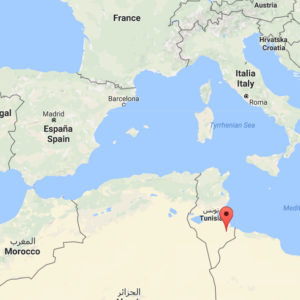 Tataouine, Tunisia
Tataouine, TunisiaFell 2001 January 8, 3:00 hrs local time
Ordinary chondrite L6
Main mass 6 500 g
History:
At 3:00 p.m. (local time) on January 8, 2001, a meteorite fell in the Beni M’hira region in southeastern Tunisia (Fig. 1). The fall was witnessed by the inhabitants of Ksar Beni M’hira (~32°52′ N 10°48′ E), a small village ~35 km east of Foum Tataouine, a place well-known in meteoritics as “Tatahouine.” After the appearance of a fireball accompanied by detonations, the meteoroid hit unpaved ground, generating a small pit ~15 cm wide and deep. On impact with the ground, the meteorite broke into three pieces, weighing 1.720, 0.300, and 0.200 kg and each partially covered by a thin, matt-black fusion crust. The three masses were found by a local shepherd and consigned to the Garde National. After being inspected by officers at the Ministère des Affaires Intérieures, the three stony fragments were sent to the Départment de Géologie of Tunis Faculty of Science for curation and initial petrographic characterization. An additional 7 pieces totalling >14 kg were later recovered by private finders in April 2001. The specimens in wellcurated collections are: 2190 g, Tunis Faculty of Science; 29.2 g, Pisa University’s Museo di Storia Naturale; 467.7 g (from the late recoveries), Museum National d’Histoire Naturelle, Paris, France.
Specimen Description:
This is a complite piece with super fresh crust and impact marks. Piece is the main mass of this fall. This piece was purhaced from a Morocan/French meteorite dealer Mohammed Hmani.
“I got some fresh samples from a French guy who was in Tunisia in 2001 and saw the meteorite fall. Then he followed it and found many pieces and took them to France, that’s why they still have a black fusion crust.” wrote Mohammed Hmani
References:
Metbull database
Beni M´hira, The forgotten meteorite: Pierre-Marie Pele
Jarkko Kettunen Meteorite Collection © 2025
